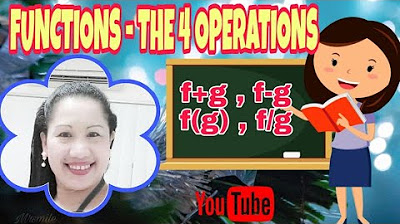Operation of Functions
Summary
TLDRIn this educational video, Teacher SP explains the four fundamental operations of functions: addition, subtraction, multiplication, and division. The video provides clear examples of how to evaluate these operations, emphasizing the importance of not dividing by zero. The teacher demonstrates with functions f(x) = x - 3 and g(x) = x + 5, showing how to perform the operations and simplify the results. The lesson is designed to help viewers understand and apply these operations to functions effectively.
Takeaways
- 📚 The video discusses the fundamental operations of functions, focusing on addition, subtraction, multiplication, and division.
- 🔢 Addition of functions is defined as the sum of f(x) and g(x), represented as f(x) + g(x).
- ➖ Subtraction of functions is defined as the difference of f(x) and g(x), represented as f(x) - g(x).
- 🔄 Multiplication of functions is defined as the product of f(x) and g(x), represented as f(x) * g(x).
- 🔄 Division of functions is defined as the quotient of f(x) and g(x), represented as f(x) / g(x), with the caveat that g(x) cannot be zero to avoid undefined results.
- ❌ Division by zero is emphasized as undefined, using the example of eight divided by zero.
- 📘 An example is provided to demonstrate the operations: f(x) = x - 3 and g(x) = x + 5, showing how to apply the four operations.
- 🧮 For addition, the example simplifies to 2x + 2, and then factors out to 2(x + 1).
- 📉 For subtraction, the example results in -8 after applying the rules of integer subtraction.
- 📊 For multiplication, the example uses the FOIL method for binomials, resulting in x^2 + 2x - 15.
- 📌 For division, the example shows that binomials cannot be directly divided or cancelled out in the context of the operations discussed.
Q & A
What are the four fundamental operations of functions?
-The four fundamental operations of functions are addition, subtraction, multiplication, and division.
How is the sum of two functions f(x) and g(x) defined?
-The sum of two functions f(x) and g(x) is defined as f(x) + g(x).
What is the difference between the functions f(x) and g(x) when f(x) is 10 and g(x) is 2?
-The difference between the functions f(x) and g(x) when f(x) is 10 and g(x) is 2 is 8, as 10 - 2 equals 8.
What is the product of the functions f(x) and g(x) when f(x) is 3 and g(x) is 5?
-The product of the functions f(x) and g(x) when f(x) is 3 and g(x) is 5 is 15, as 3 times 5 equals 15.
Why is division by g(x) not allowed when g(x) equals zero?
-Division by g(x) is not allowed when g(x) equals zero because it results in an undefined expression, as division by zero is undefined in mathematics.
What is the result when you add the functions f(x) = x - 3 and g(x) = x + 5?
-The result when you add the functions f(x) = x - 3 and g(x) = x + 5 is 2x + 2, after simplifying the expression.
How do you find the difference between the functions f(x) = x - 3 and g(x) = x + 5?
-To find the difference between the functions f(x) = x - 3 and g(x) = x + 5, you subtract g(x) from f(x), resulting in -8 after applying the subtraction rules.
What is the product of the binomials (x - 3) and (x + 5) using the FOIL method?
-Using the FOIL method, the product of the binomials (x - 3) and (x + 5) is x^2 - 3x + 5x - 15, which simplifies to x^2 + 2x - 15.
Why can't you directly divide the binomials (x - 3) by (x + 5)?
-You can't directly divide the binomials (x - 3) by (x + 5) because they are not in a form that allows for simple cancellation or direct division as they are both binomials.
What is the final simplified form of the expression 2x + 2 after factoring out the common factor?
-The final simplified form of the expression 2x + 2 after factoring out the common factor 2 is 2(x + 1).
Outlines

This section is available to paid users only. Please upgrade to access this part.
Upgrade NowMindmap

This section is available to paid users only. Please upgrade to access this part.
Upgrade NowKeywords

This section is available to paid users only. Please upgrade to access this part.
Upgrade NowHighlights

This section is available to paid users only. Please upgrade to access this part.
Upgrade NowTranscripts

This section is available to paid users only. Please upgrade to access this part.
Upgrade NowBrowse More Related Video

Operation on Functions/Teacher Espie

ATURAN DASAR OPERASI MATEMATIKA

As Quatro Operações Básicas da Matemática - Matemática 2º Ano - 22/11/2021

Komposisi Fungsi Part 1 - Operasi Aljabar Pada Fungsi [ Matematika Wajib Kelas X ]

OPERAÇÕES: ADIÇÃO, SUBTRAÇÃO, MULTIPLICAÇÃO E DIVISÃO | MATEMÁTICA BÁSICA #2 | Prof. Diego Viug

SHS General Mathematics Q1 Ep1: Function
5.0 / 5 (0 votes)